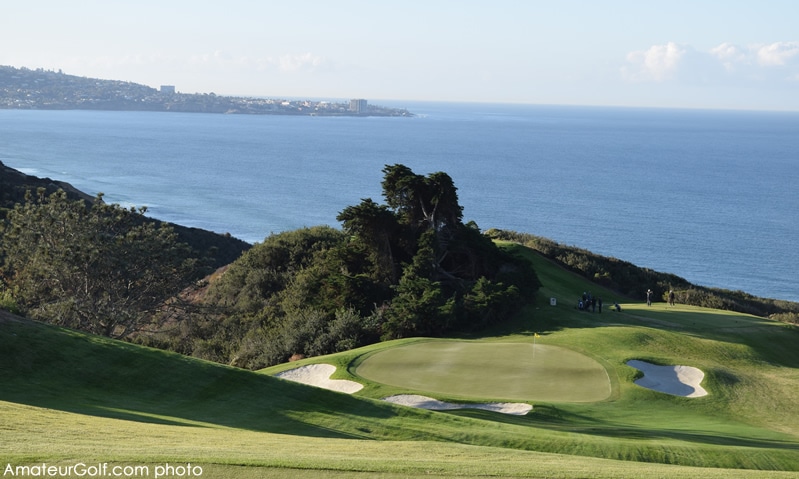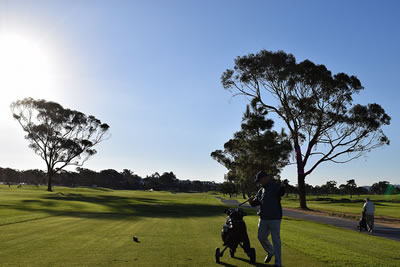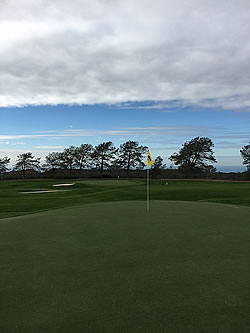Open for Play: Torrey Pines North Course Review
1/3/2017 | by Pete Wlodkowski of AmateurGolf.com
see also: Torrey Pines Golf Club - North Course, All Course Reviews

With the completion of a $12.6M Tom Weiskopf redesign, San Diego's 36-hole Torrey Pines Golf Course boasts the best pair of "munis" in the U.S.
Now that the makeover of Torrey Pines' North Course is complete, San Diego has arguably the best 36-hole city-owned golf complex in the United States.
Sure, I'm biased -- I live just 17 miles from the clubhouse and am a member of the Torrey Pines Men's Club. I've played dozens of rounds at both layouts, mostly at the local rate afforded to members of the 1000-player large group. Whenever I play either course, I feel a sense of wonder gazing down the bluffs south towards La Jolla or north towards Carlsbad. If you've watched the PGA Tour Farmers Insurance Open on television (or played Torrey) you know what I mean.
When rumors of a North Course renovation first started circulating, I doubted it would happen. I knew the course (especially the greens) needed a makeover, but figured it was fine having two "grades" of golf course, with two different greens fee structures to balance the play equally between South and North. Now that I've seen the result, I think the $12.6 million invested was money well spent. Architect Tom Weiskopf (who got his first PGA Tour win at Torrey Pines in 1968) invested the time to listen to the concern of locals, and the result is a very forgiving layout, especially off the tee when compared to the South.
 |
The 18th hole
is now a long par-4 with a much-improved
green |
“There was never a thought in my mind to compete against the South Course, in difficulty or challenge or anything like it,” Weiskopf told the Union Tribune at a recent media day. “We needed something that was a better, more modernistic golf course built with the highest specifications.”
The thing about renovations is that the longer people have grown accustomed to a layout, the more critical they can be. It's not uncommon to hear a local say "they've ruined it" after any remodel, and I know many people who say that about the South Course, but I personally think the Rees Jones design of the South is a masterpiece. But I can understand people who think it's too tough, or that the redesign took away some of the charm of the "old" South Course. At the same time, I always wrote off their complaints to nostalgia. And since I didn't have a long history in San Diego I didn't feel any of that.
But after 14 years of playing Torrey Pines North, I feel pretty attached to it. I thought it was fine the way it was, but I recognized the maintenance and infrastructure issues that needed to be addressed. I was most concerned that the layout would change dramatically with the remodel, but it hasn't. The front and back nines were flipped, so that the North doesn't start with a par-5 and the most scenic holes are now on the back nine.
Nothing wrong with that. The only other major design change was moving the green on the old 8th hole (No. 17) to the left and further back, creating a hole that stretches to around 525-yards but which will still offer great risk and reward -- playing well on TV or with your foursome's long hitters. Like the other greens, the 17th green is huge, but it looks small from the fairway because of the narrow opening and it's depth. It's a brilliant design that takes advantage of the canyon that borders the entire left side of the hole. With trees removed the hole has a real "resort" feel which I love.
In making that change, Weiskopf had to get a shot back to keep the par at 72, and he did that at the 18th hole (old No. 9) where a fairly boring par-5 with one of the worst greens on the course is now a par-4 that can stretch to almost 500 yards. The green is much bigger and wider, with a nice variety of hole locations. It's going to make for a great finish.
 |
The devilish
back-left pin placement on the 6th hole
|
I loved the small greens on the old North; the new ones -- which are 20-30% larger -- seemed gigantic and out of place during my first round. But the fact is, large greens probably make more sense at a municipal layout. And from a pro's perspective, even though the PGA visits only once a year I have a feeling they are going to love the options that the bigger greens bring into play. I'll give you just one example from my first go around, on the 6th (old 15) hole. The back-left pin there was always risky to fire at, even with a short iron. Now, a more pronounced slope with closely-mown grass and no trees in sight make for a downright scary approach shot.
The "no trees" is a theme around the new North, where Weiskopf has removed a large number of trees and brought in some native areas to save on water and add a more open look to the course. And that's probably the thing I like the best about the remodel. The two courses compliment each other very well. Play 36-holes over a single day or multiple days and you're going to enjoy the variety, whether you choose the middle tees at 6,346 yards or the 7,258 yard pro tees. Don't worry, those back tees will likely be "special invitation" as they are on the South, and past experience tells me, don't bother asking unless you play on a pro tour someplace.
Most Popular Articles

2025 PGA TOUR Q-School Guide: Sites, Scores, and Who Advanced
Dec 5, 2025Second Stage is complete and Final Stage awaits at Sawgrass — follow every Q-School leaderboard and the players still chasing
2025 LPGA TOUR Q-Series: Final Qualifying Stage FINAL SCORING
Dec 8, 2025Helen Briem earns medalist honors, 31 players headed to the LPGA next year
Australian Open at Royal Melbourne: Preview, amateur bios, and how to watch
Nov 30, 2025Rory McIlroy headlines one of the championship's top fields in years - at least four amateurs will have their chance at glory
Luke Ringkamp Cruises to Rolex Tournament of Champions Title at TPC San Antonio
Nov 26, 2025One week after committing to Pepperdine, Luke Ringkamp won the Rolex Tournament of Champions by nine shots.Inside Gil Hanse’s Restoration of Baltusrol’s Upper Course: A Return to Tillinghast’s
Dec 11, 2025Renowned architect Gil Hanse reveals how he brought Baltusrol’s Upper Course back to life by honoring A.W. Tillinghast’s originalLoading latest news...
